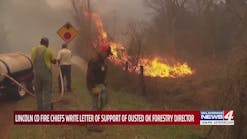Michigan FD Struggling With Response Times, Staffing
Source The Record-Eagle, Traverse City, Mich.
TRAVERSE CITY, Mich. -- Patty Schropp thought there would be, should be more firefighters.
She awoke to shouting and banging on her door early one morning in July 2011. The roof of her third floor home at Alpine Apartments in Traverse City was ablaze and flames began to carve through her ceiling.
She scurried down a stairwell and to safety. There, as smoke roiled and flames spread, she spied one fire truck and two Traverse City firefighters.
"It was an apartment building, a lot of people live there," Schropp said. "When you have a fire truck that shows up with almost nobody on it, what are they going to do? Two firefighters and one truck is not going to cut it."
Less than a year after Schropp's harrowing escape, Traverse City commissioners and city fire department members battled over a proposal to lay off firefighters in a budget-balancing effort. They debated nearly two months before brokering a compromise, but no mention was made of the Alpine fire and questions it raised about the city's ability to provide adequate response to a major fire.
Small response to big blaze
The city relies on early detection and a quick attack by small crews to knock down most fires, but it backfired at the Alpine, one of more than 50 apartment buildings of 10 units or more in the city.
A lightning strike sparked fire in the attic and it quickly spread because large holes for television cables had been cut in attic fire walls designed to contain a blaze. An elderly resident later died from complications of smoke inhalation, and a firefighter was burned when a ceiling collapsed on him.
Shorthanded, firefighters relied on police to evacuate the building, and they overlooked two families -- six people in all. They wandered out on their own about 45 minutes later.
"Anyway you look at it, it wasn't a good situation. But you have a certain amount of resources and now they want us to do with even less," said Lt. Mike Onthank, president of the Traverse City firefighters' local union. "If you asked someone on the street how many people are in the fire station, no one would know. They all think there is more."
On a typical day, from 8 p.m. to 7 a.m., the city has five or six firefighters to staff two stations. Grand Traverse Metro Fire Department sends a fire truck and two firefighters to most city structure fires, thanks to an automatic aid agreement. Since the Alpine fire and institution of a new dispatch system, Metro will send two trucks to some fires.
Most firefighters live outside city
The city's off-duty personnel also are expected to respond when called out.
City Fire Chief Jim Tuller and Lt. Brian Snyder are the only members of the 24-member department who live in Traverse City. Under state law, firefighters must live within 20 miles of the city limits.
The average city firefighter lives more than 10 miles and a 16-minute drive from the city fire station nearest their home, based on a Record-Eagle review of address information compiled from public records and using drive times and mileage from Mapquest.com.
Two city firefighters live within 10 minutes of a city station, while the most remote firefighter has a 25-minute drive.
Three live outside the county, including one in Suttons Bay. Onthank lives in Lake Ann.
"I've lived in Lake Ann since 1972 and I like the wide open area and when I got this job I didn't consider moving into the city," Onthank said. "A lot of us are big hunting guys and fishing guys and we like to live outside in the country."
The distance from city fire stations concerns Mayor Michael Estes, who wants to explore alternative fire department models that would employ fewer full-time staff and more part-time firefighters.
"Most cities respond far better because the people who respond to a crisis are close by," Estes said. "How is someone going to get from Suttons Bay to Traverse City to fight a fire?"
Tuller said he's not troubled by occasionally slow response by off-duty personnel. Such delays are factored in through advance planning and a dispatch system that automatically sends help from adjoining fire departments.
"The first few critical minutes are when the outcome of the emergency is decided," Tuller said. "To have personnel come in quickly from outside departments is a great asset."
Tuller declined to speculate how the new system might have affected firefighting and rescue operations during the Alpine fire.
An official review by the city and Grand Traverse Metro found the Alpine response inadequate.
The first city fire engine, with two people, arrived within 3 minutes of being dispatched. A Metro truck arrived next with two firefighters, followed by a second city engine with three people.
Subpar response times
The turnout failed to meet national standards even for volunteer fire departments, which recommend assembling 10 firefighters on scene within 10 minutes 80 percent of the time.
The Alpine response reached nine firefighters when Tuller and Assistant Metro Chief Terry Flynn showed up at the 17-minute mark, dispatch records show.
It took the first off-duty city firefighter 34 minutes to arrive at Alpine Apartments with the city's ladder truck, which was needed to extinguish the fire. The rest of the off-duty personnel arrived 44 minutes after the initial fire call, dispatch records show. Tuller reported the fire "under control" 30 minutes later.
City records show the department responds on average to about 66 fires a year out of about 1,100 calls for service.
Onthank said in a "perfect world" the department would staff 12 to 15 firefighters per shift, but the city can't afford that expense.
"I think it would be nice to have 10 on the crew; we did have that at one time," Onthank said. "It would be the safest for us, it would be the safest for the residents."
Terry Heyns, a professor of fire science at Lake Superior State University, recommends that every truck carry a command officer, a driver/pump operator, and a minimum of two to three firefighters.
A smaller turnout saddles first responders with a wider range of responsibilities, and those concerns are multiplied in older, remodeled structures such as the Alpine, Heyns said. But budget pressures nationwide have led to smaller fire departments and more incidents similar to the Alpine.
"The issue is what's the community willing to spend ... and how many casualties are we willing to accept," he said.
At an estimated cost of $70,000 per firefighter, and three people needed to add one around-the-clock position, the cost would be "through the roof," Estes said.
"You cannot raise city taxes and expect people to live here," Estes said. "I'm sure one of the reasons firefighters are living outside of the city is because the taxes are so high."
Copyright 2012 - The Record-Eagle, Traverse City, Mich.
McClatchy-Tribune News Service





